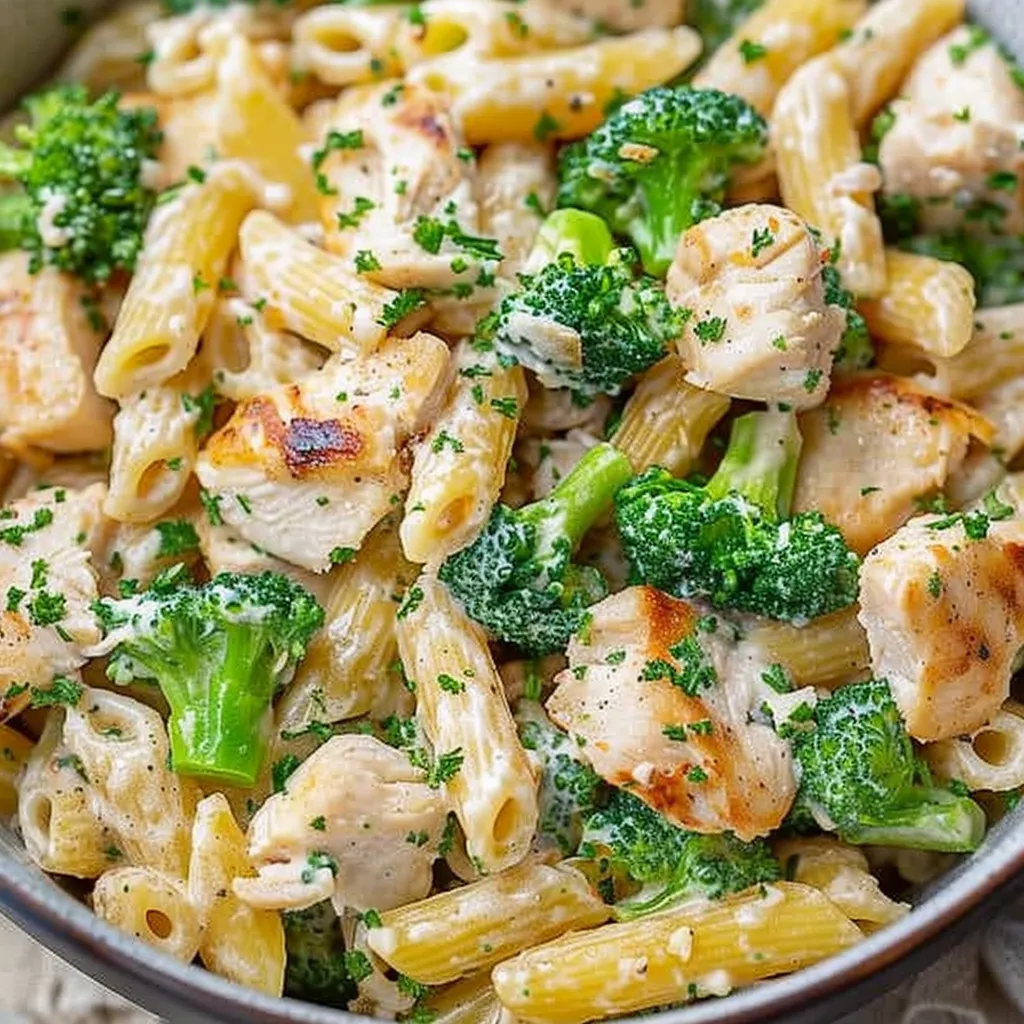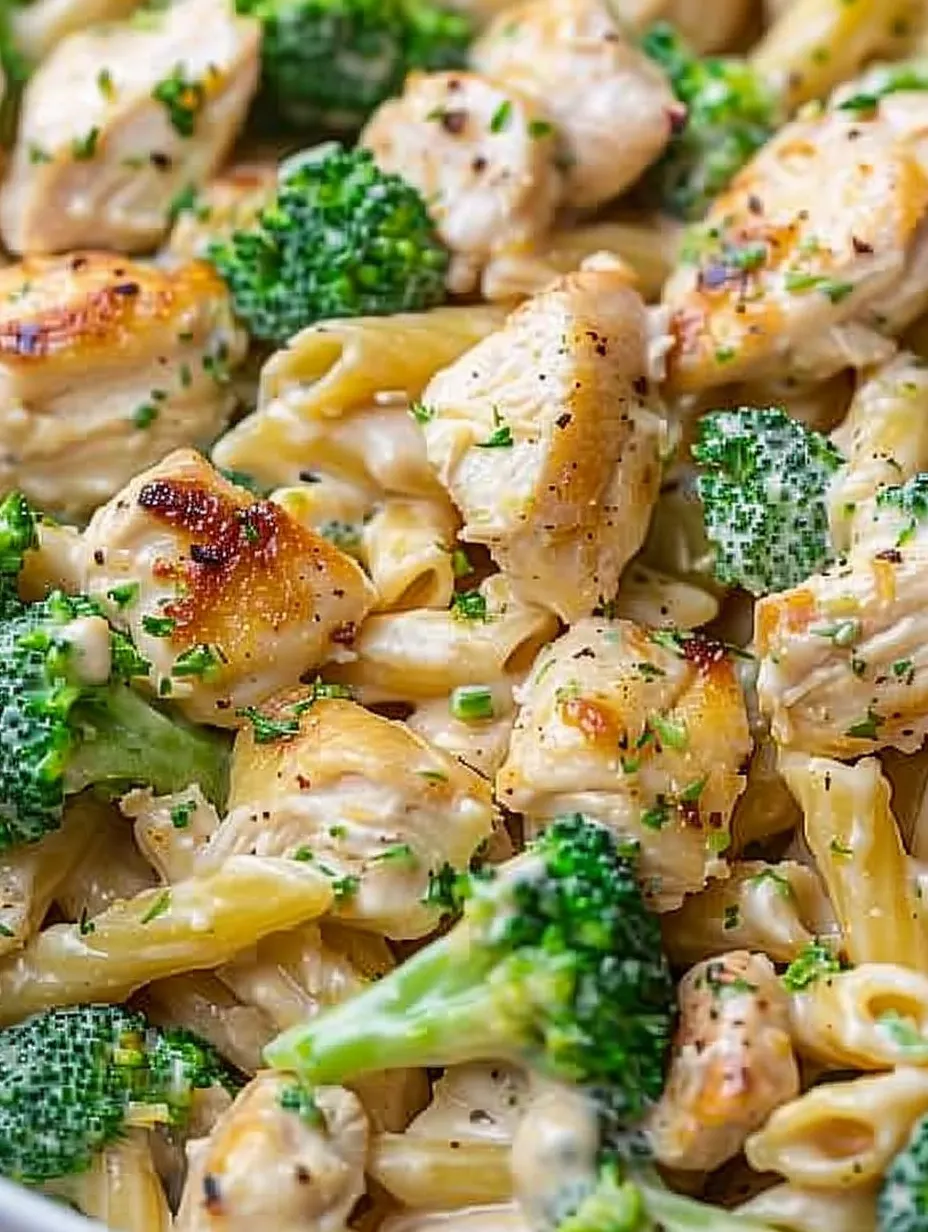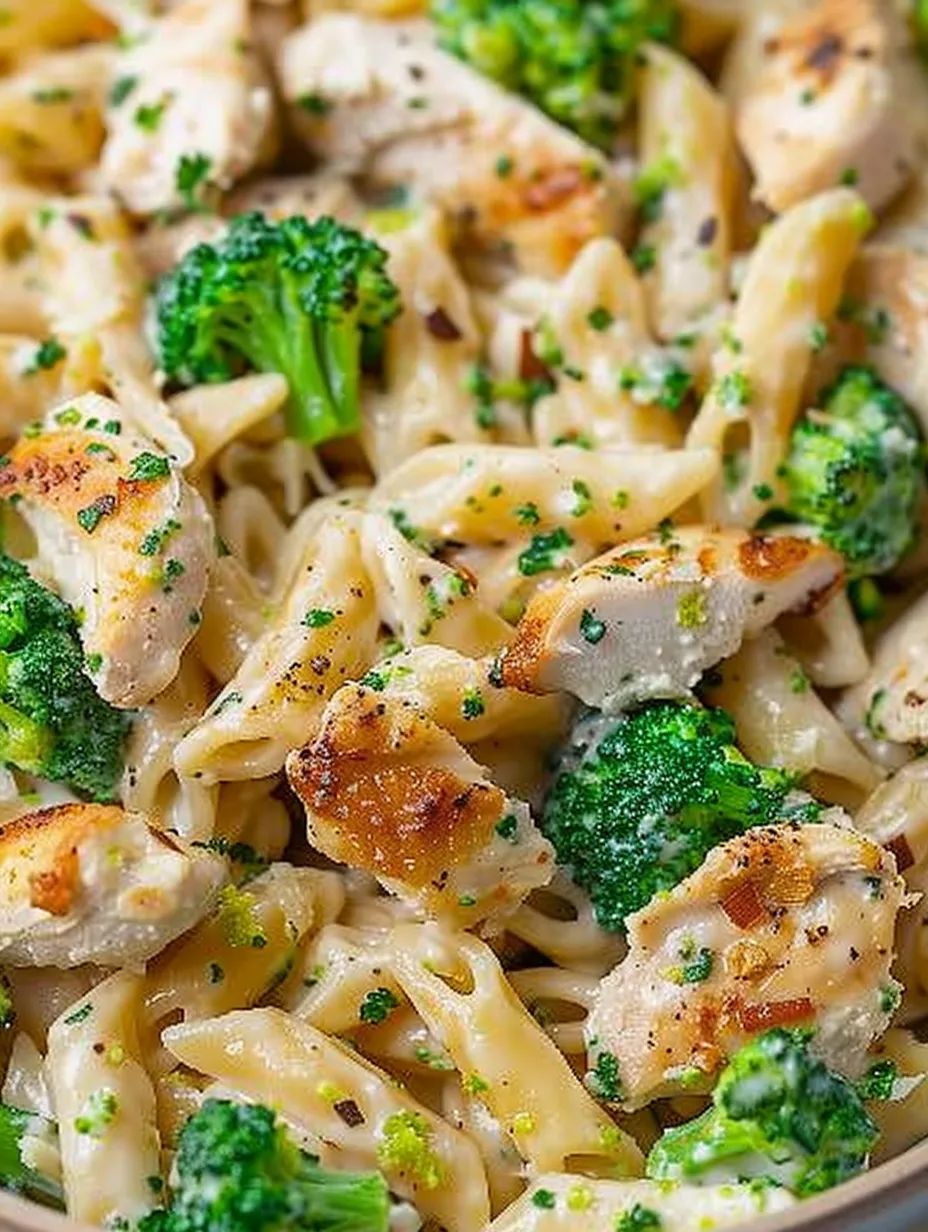 Pin it
Pin it
Tender pieces of chicken and bright green broccoli florets nestled among perfectly cooked pasta, all enveloped in a velvety, Parmesan-infused sauce create a dinner that's both satisfying and simple. This Chicken and Broccoli Pasta brings together protein, vegetables, and carbs in one delicious dish that comes together quickly enough for weeknights but tastes special enough for weekend dinners. The garlicky cream sauce ties everything together with its rich flavor, coating every bite with creamy goodness that will have everyone reaching for seconds.
I started making this pasta dish when looking for ways to get my children to eat more vegetables without complaint. What began as a simple "hide the broccoli" strategy quickly became one of our family's most requested meals. My husband, who claimed to dislike creamy pastas, found himself going back for seconds and asking for it to be added to our regular rotation. The combination of tender chicken, perfectly cooked broccoli, and that garlic-infused sauce seems to win over even the most reluctant diners.
Comforting Components
- Penne pasta: Creates the perfect foundation for catching sauce in its ridges and tubes. Any short, sturdy pasta works beautifully in this versatile dish.
- Fresh broccoli: Adds vibrant color, nutrition, and slightly sweet flavor. Cutting florets to similar sizes ensures even cooking throughout.
- Chicken breasts: Provide lean protein and satisfying substance. Pre-cooked rotisserie chicken saves time without sacrificing flavor.
- Onion and garlic: Form the aromatic flavor base that elevates the entire dish. Fresh garlic offers significantly more flavor than pre-minced varieties.
- All-purpose flour: Works with fat to create a roux that thickens the sauce perfectly. Measuring accurately prevents lumps or overly thick sauce.
- Whole milk: Creates rich creaminess without the heaviness of cream. Full-fat provides the best texture, though lower-fat versions work in a pinch.
- Parmesan cheese: Adds savory depth and thickening power to the sauce. Freshly grated melts more smoothly than pre-packaged varieties.
- Olive oil: Provides the fat foundation for sautéing and building flavor. Extra virgin offers the most flavor, though regular olive oil works well too.
 Pin it
Pin it
One-Pot Wonder
- Pasta Perfection:
- Begin by bringing a large pot of water to a rolling boil over high heat. This is one step where patience pays off – a proper boil ensures your pasta cooks evenly. Once boiling, add a generous tablespoon of salt to the water. This isn't just tradition; it actually seasons the pasta from within as it cooks. Add your penne pasta and cook according to package directions, typically 9-11 minutes for al dente. About 5 minutes before the pasta is done, add the broccoli florets directly to the boiling pasta water. This clever time-saver cooks the broccoli to perfect tenderness while saving you the trouble of dirtying another pot. When done, drain the pasta and broccoli together, being careful not to rinse, as the starchy exterior helps the sauce adhere better.
- Sauce Development:
- While the pasta cooks, start building your sauce in a large, deep skillet. Heat olive oil over medium heat until it shimmers slightly, then add your diced onion. Cook for 2-3 minutes, stirring occasionally, until the onion becomes translucent but not browned. Add the minced garlic along with salt and pepper, reducing the heat slightly to prevent burning. After about 60 seconds, when the garlic becomes fragrant, sprinkle the flour over the mixture. This creates a roux, which will thicken your sauce. Cook for 1-2 minutes, stirring constantly with a wooden spoon or whisk to prevent burning. The mixture should look like a thick paste and smell slightly toasty but not burnt.
- Creamy Transformation:
- Now comes the magic moment when your roux transforms into a silky sauce. Gradually pour in the milk, whisking constantly to prevent lumps from forming. Adding the milk slowly is crucial – a steady stream allows it to incorporate smoothly without forming clumps. Once all the milk is added, continue cooking for 2-3 minutes, stirring occasionally as the sauce thickens. You'll know it's ready when it coats the back of a spoon and a line drawn through it with your finger remains clear. Reduce the heat to low and add the grated Parmesan cheese, stirring until completely melted. The sauce should be smooth and velvety, thick enough to coat pasta but still relatively fluid.
- Bringing It All Together:
- The final step is combining all your components into one harmonious dish. Add the drained pasta and broccoli to your sauce, along with the diced cooked chicken. Gently fold everything together using a wooden spoon or silicone spatula, being careful not to break the pasta or crush the broccoli. Continue folding until every piece is coated with the creamy sauce. Allow everything to simmer together for 2-3 minutes, which helps the flavors meld and ensures everything is heated through. If the sauce seems too thick, add a splash of milk or some of the reserved pasta water to reach your desired consistency.
I discovered the simple trick of cooking broccoli with pasta after years of unnecessarily dirtying multiple pots. This technique not only streamlines the cooking process but actually improves the dish – the broccoli picks up some starch from the pasta water, helping the sauce cling to it better. Now I use this method for all my pasta-vegetable combinations.
Perfect Pairings
Complete your meal by serving this creamy pasta alongside a simple arugula salad dressed with lemon juice and olive oil, providing a peppery, acidic counterpoint to the rich main dish. A glass of crisp Pinot Grigio or Sauvignon Blanc offers refreshing contrast for adults, while kids enjoy it with berry-infused water for a special touch. For a heartier meal, add garlic bread on the side – its crunchy texture complements the creamy pasta perfectly while providing something to soak up every last bit of the delicious sauce. When entertaining, start with an antipasto platter featuring marinated vegetables, cheese, and olives before serving this comforting pasta as the main attraction.
Flavor Variations
Transform this versatile recipe by experimenting with different ingredients and flavors. For a Mediterranean twist, add halved cherry tomatoes, pitted kalamata olives, and a sprinkle of feta cheese just before serving. Seafood lovers can substitute shrimp or salmon for chicken, paired with a squeeze of lemon juice to brighten the flavors. Mushroom enthusiasts will enjoy adding sautéed cremini or shiitake mushrooms for earthy depth. For a spicier version, incorporate red pepper flakes into the sauce or stir in some sun-dried tomato pesto. Vegetarians can skip the chicken altogether and increase the vegetables, perhaps adding cauliflower or asparagus alongside the broccoli for variety and substance.
 Pin it
Pin it
Fresh Tomorrow
Store any leftover pasta in an airtight container in the refrigerator for up to three days. The flavors actually develop overnight, making next-day leftovers particularly delicious. When reheating, add a splash of milk to revive the sauce, which tends to thicken when chilled. Gently warm over medium-low heat on the stovetop, stirring occasionally to prevent sticking and burning. Alternatively, microwave at 70% power in short intervals, stirring between each, to prevent overheating which can cause the sauce to separate. While freezing isn't ideal due to the cream-based sauce, you can freeze individual portions in airtight containers for up to one month if necessary. Thaw overnight in the refrigerator before reheating for best results.
After years of making countless pasta dishes, this creamy chicken and broccoli version remains one of my most reliable recipes. What makes it special isn't complicated techniques or hard-to-find ingredients, but rather the perfect balance of flavors and textures that creates something greater than the sum of its parts. The way the creamy sauce clings to both the pasta and vegetables, the tender bites of chicken throughout, and that perfect garlic undertone make this a dish that feels like home – simple, satisfying, and always welcome at the dinner table.
Frequently Asked Questions
- → Can I use different pasta shapes?
- Absolutely! While penne works great because the sauce gets inside the tubes, you can use any pasta shape you have on hand. Farfalle (bow ties), fusilli (spirals), or rigatoni all work well. Just follow the cooking time on whatever pasta package you're using.
- → How can I make this dish lighter?
- To make a lighter version, you can use 2% or even skim milk instead of whole milk, though the sauce won't be quite as creamy. You could also use half the amount of parmesan and add a little nutritional yeast for flavor. Another option is to increase the ratio of broccoli to pasta.
- → Can I use frozen broccoli instead of fresh?
- Yes, frozen broccoli works fine in this recipe. Since frozen broccoli is already blanched, you'll want to add it during the last 2-3 minutes of pasta cooking time instead of 5 minutes. Just make sure to thaw and drain it first to avoid watering down your sauce.
- → What's the best way to prepare the chicken?
- For the quickest option, use rotisserie chicken or leftover cooked chicken from another meal. If you're cooking chicken specifically for this dish, seasoning chicken breasts with salt and pepper and sautéing them in a bit of olive oil for about 6-7 minutes per side until they reach 165°F internally works great. You could also poach the chicken in a bit of broth while the pasta is cooking.
- → How can I add more flavor to this dish?
- There are lots of ways to customize the flavor! Try adding red pepper flakes for heat, sun-dried tomatoes for tanginess, or mushrooms for earthiness. Fresh herbs like basil or parsley added at the end brighten it up nicely. You could also use half and half instead of milk for extra richness, or add a splash of white wine when sautéing the onions.
